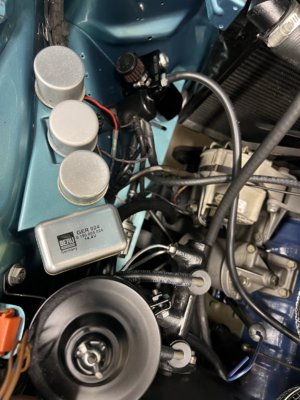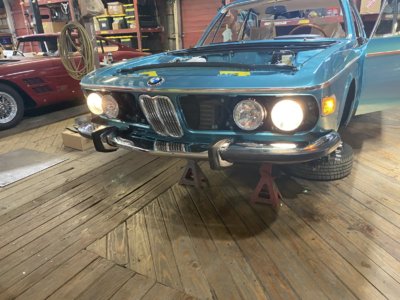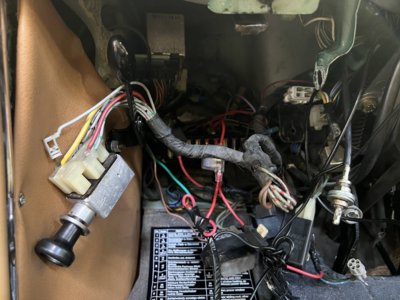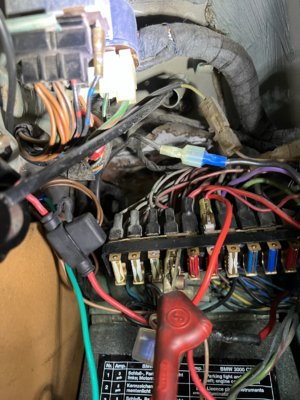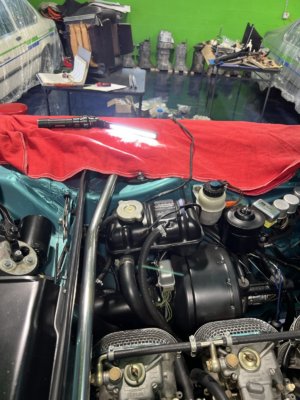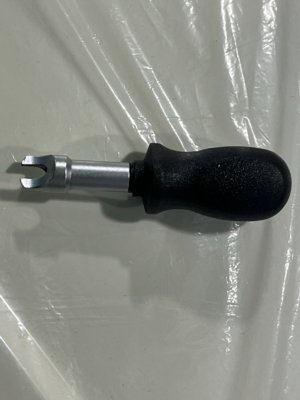During the first week of November, I drove 500 miles to Hilton Head/LOTA East/Octoberfest. The car ran fine until I had a voltage surge that had numerous things all happen at once to the electrical system. The wipers started going 100 MPH without being turned on. The tach bounced all over the place. The car backfired and then went dead on the side of a 2 lane road. The car was towed to a BMW/Mercedes shop owned by a guy who has worked on these cars for over 25 years. He found the 12 month old red-top AGM Optima battery had an internal failure that caused the voltage surge. He replaced it with a World brand AGM battery he uses in small airplanes. The car started right up and I drove it for several days in the pouring rain and then 500 miles back home. The surge blew out my fog light switch indicator bulb and both 20 watt city lights I use as daytime running lights in my Hella headlights with H4 bulbs. I also lost my quartz restored clock.
I knew I had to check the alternator and voltage regulator. The Bosche alternator is putting out 14 volts at the terminals. My voltage regulator was giving me 12-17 volts at the trunk-mounted battery and I suspect that is what caused the Omni battery to fail.The mechanic back in South Carolina told me the Optima battery is designed for modern cars with 95 amp output and is not a good application for our 45 amp alternators. I bought a new voltage regulator and a plug-in voltmeter-Equus3721 diagnostic tool. This $20 device plugs into your cigar lighter and gives you real time voltage and charging status while driving. I bought it on EBay and now know the charging system is working correctly.
About 3 weeks ago,I start up the car and turn on the headlights. The instrument lights are on until I slam the door shut. The instrument lights go out and #2 fuse is blown. The label says #2 fuse is only for the license plate and instrument lights. I then disconnect the license lights after inspecting the wires for a short. Now that there is no load on the license lights/wiring, the new fuse blows out the instant the light switch is turned on. That means the short is somewhere in the dash.
Has anyone had a similar problem and can tell me where to look for a short?
Today I started the car and turned on the headlights. My H4 bulb on low beam on the passenger side is now a dull yellow. I pulled the headlight and measured only 4.5 volts in the terminal.
Has anyone had this electrical problem? Please note this is a USA car that had the traditional sealed beam headlights and the H4 Hella's have been working for over a year w/o problems.
The first pic is the new Behru regulator. The 2nd pic is the 20 watt halogen "city lights" that were custom wired to be used as daytime running lights operated by the green fog light switch under the steering wheel. The headlight buckets had to be cut to allow the extra city light to fit into the bucket.
I knew I had to check the alternator and voltage regulator. The Bosche alternator is putting out 14 volts at the terminals. My voltage regulator was giving me 12-17 volts at the trunk-mounted battery and I suspect that is what caused the Omni battery to fail.The mechanic back in South Carolina told me the Optima battery is designed for modern cars with 95 amp output and is not a good application for our 45 amp alternators. I bought a new voltage regulator and a plug-in voltmeter-Equus3721 diagnostic tool. This $20 device plugs into your cigar lighter and gives you real time voltage and charging status while driving. I bought it on EBay and now know the charging system is working correctly.
About 3 weeks ago,I start up the car and turn on the headlights. The instrument lights are on until I slam the door shut. The instrument lights go out and #2 fuse is blown. The label says #2 fuse is only for the license plate and instrument lights. I then disconnect the license lights after inspecting the wires for a short. Now that there is no load on the license lights/wiring, the new fuse blows out the instant the light switch is turned on. That means the short is somewhere in the dash.
Has anyone had a similar problem and can tell me where to look for a short?
Today I started the car and turned on the headlights. My H4 bulb on low beam on the passenger side is now a dull yellow. I pulled the headlight and measured only 4.5 volts in the terminal.
Has anyone had this electrical problem? Please note this is a USA car that had the traditional sealed beam headlights and the H4 Hella's have been working for over a year w/o problems.
The first pic is the new Behru regulator. The 2nd pic is the 20 watt halogen "city lights" that were custom wired to be used as daytime running lights operated by the green fog light switch under the steering wheel. The headlight buckets had to be cut to allow the extra city light to fit into the bucket.

